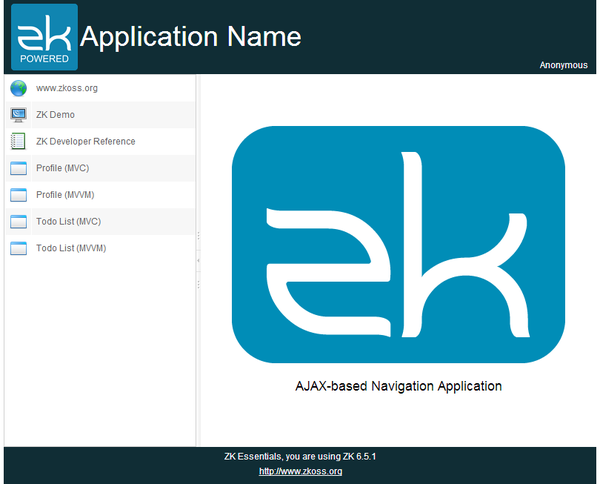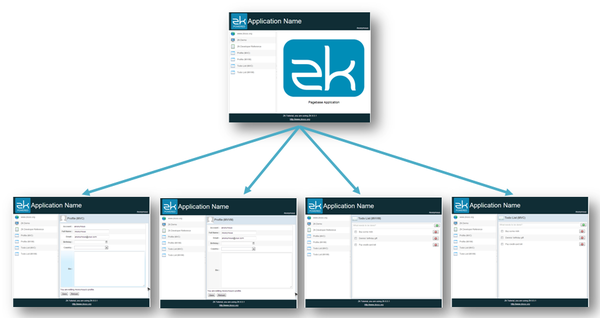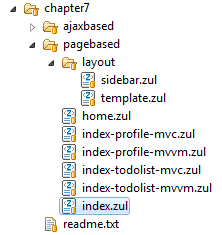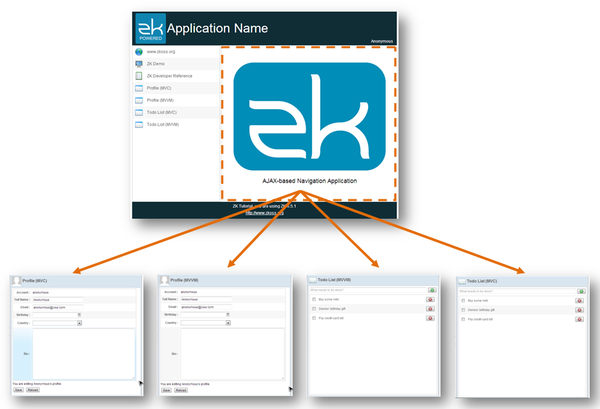Chapter 7: Navigation and Templating"
| Line 219: | Line 219: | ||
'''chapter7/ajaxbased/index.zul''' | '''chapter7/ajaxbased/index.zul''' | ||
| − | <source lang='xml' high=' | + | <source lang='xml' high='5,6'> |
<?link rel="stylesheet" type="text/css" href="/style.css"?> | <?link rel="stylesheet" type="text/css" href="/style.css"?> | ||
| − | <?init class="org.zkoss.zk.ui.util.Composition" arg0="/chapter7/ajaxbased/layout/template.zul"?> | + | <?init class="org.zkoss.zk.ui.util.Composition" |
| + | arg0="/chapter7/ajaxbased/layout/template.zul"?> | ||
<zk> | <zk> | ||
| − | <include id="mainInclude" self="@define(content)" src="/chapter7/ajaxbased/home.zul"/> | + | <include id="mainInclude" self="@define(content)" |
| + | src="/chapter7/ajaxbased/home.zul"/> | ||
</zk> | </zk> | ||
</source> | </source> | ||
| − | * Line | + | * Line 5,6: We give the component id for we can find it later with ZK selector. |
This navigation is mainly implemented by changing the <tt>src</tt> attribute of the ''Include'' component to switch between different zul pages so that it only reloads included components without affecting other areas . We still need to initialize sidebar configuration: | This navigation is mainly implemented by changing the <tt>src</tt> attribute of the ''Include'' component to switch between different zul pages so that it only reloads included components without affecting other areas . We still need to initialize sidebar configuration: | ||
| Line 320: | Line 322: | ||
Visit the http://localhost:8080/essentials/chapter7/ajaxbased/index.zul to see the result. | Visit the http://localhost:8080/essentials/chapter7/ajaxbased/index.zul to see the result. | ||
| − | |||
= Source Code = | = Source Code = | ||
Revision as of 10:24, 2 July 2014
![]() This article is out of date, please refer to http://books.zkoss.org/zkessentials-book/master/ for more up to date information.
This article is out of date, please refer to http://books.zkoss.org/zkessentials-book/master/ for more up to date information.
Overview
In traditional navigation, a user usually switches to different functions by visiting different pages of an application, a.k.a page-based navigation. In ZK, we can have another choice to design the navigation in AJAX-based where users don't need to visit different pages. In page-based navigation, users need to switch pages frequently, we should maintain a consistent page design throughout whole application to help users keep track of where they are. Luckily ZK provides Templating to keep multiple pages in the same style easily.
In this chapter, the example application we are going to build looks as follows:
The sidebar is used for navigation control. The lower 4 menu items lead you to different functions and they only change the central area's content. All other areas are unchanged to maintain a consistent layout style among functions.
Templating
In our example application, we want to keep the header, the sidebar, and the footer unchanged regardless of which function a user chooses. Only the central area changes its content according to the function chosen by users.
In page-based navigation, each function is put into a separated page and we need to have a consistent style. One way is to copy the duplicated part from one zul to another, but it is hard to maintain. Fortunately, ZK provides a Templating technique that lets you define a template zul and apply it to multiple zul pages afterwards. All zul pages that apply the same template zul have the same layout, so changing the template zul can change the layout of all pages once.
The steps to use templating are:
- Create a template zul and define anchors
- Apply the template in the target zul and define zul fragments for anchors
Then when you visit the target zul page, ZK will insert those fragments to corresponding anchors upon anchor names and combine them as one page.
Create a Template ZUL File
Creating a template is nothing different from creating a normal zul, but you should define one or more anchors by specifying annotation @insert() at self. You can give any name to identify an anchor that will be used to insert a zul fragment with the same anchor name later.
chapter7/pagebased/layout/template.zul
<zk>
<borderlayout hflex="1" vflex="1">
<north height="100px" border="none" >
<include src="/chapter3/banner.zul"/>
</north>
<west width="260px" border="none" collapsible="true"
splittable="true" minsize="300">
<include src="/chapter7/pagebased/layout/sidebar.zul"/>
</west>
<center id="mainContent" autoscroll="true" border="none"
self="@insert(content)">
</center>
<south height="50px" border="none">
<include src="/chapter3/footer.zul"/>
</south>
</borderlayout>
</zk>
- Line 10,11: Define an anchor with name content
Apply the Template
After creating a template zul, we can apply it in another zul with directive
<?init class="org.zkoss.zk.ui.util.Composition" arg0="template_path"?>
This directive tells ZK that this page uses the specified template. Then we also have to define zul fragments that are inserted to the anchor in the template zul with annotation @define(anchorName) at self attribute. The anchorName you specify should correspond to one of anchors defined in the template zul.
chapter7/pagebased/index.zul
<?link rel="stylesheet" type="text/css" href="/style.css"?>
<?init class="org.zkoss.zk.ui.util.Composition"
arg0="/chapter7/pagebased/layout/template.zul"?>
<zk>
<include self="@define(content)" src="/chapter7/pagebased/home.zul"/>
</zk>
- Line 2,3: Tell ZK that we want to use a template zul for current page and give the path of template zul.
- Line 5: The anchor name content correspond to the anchor name defined in the template zul in previous section.
After above steps, when you visit http://localhost:8080/essentials/chapter7/pagebased/index.zul, ZK will render the page based on template.zul and attach the Include component to <center>.
Traditional web applications are usually designed with page-based navigation. Each function corresponds to an independent page with independent URL. The navigation is very clear for users as they know where they are from the URL and they can press "go back" button on their browser to go back to previous pages in history. But the drawback is users have to wait whole page reloading every time they switch to a function. Additionally, developers also have to maintain multiple pages that have similar contents but applying a template zul can reduce this problem.
To build a page-based navigation, first you should prepare pages for those items in the sidebar.
From above image, you can see there are four zul pages which correspond to items in the sidebar under "chpater7\pagebased" (index-profile-mvc.zul, index-profile-mvvm.zul, index-todolist-mvc.zul, index-todolist-mvvm.zul). Then we can link four items of the sidebar to these zul pages by redirecting a browser.
Next, we apply the template zul created before on those 4 pages.
/chapter7/pagebased/index-profile-mvc.zul
<?link rel="stylesheet" type="text/css" href="/style.css"?>
<?init class="org.zkoss.zk.ui.util.Composition"
arg0="/chapter7/pagebased/layout/template.zul"?>
<zk>
<include self="@define(content)" src="/chapter5/profile-mvc.zul"/>
</zk>
- Line 2,3: Apply the template in /chapter7/pagebased/layout/template.zul.
- Line 5: Define a zul fragment for the anchor content.
Our example application creates those menu items dynamically upon a configuration, so we should initialize configuration.
Page-based navigation's sidebar configuration
public class SidebarPageConfigPagebasedImpl implements SidebarPageConfig{
HashMap<String,SidebarPage> pageMap = new LinkedHashMap<String,SidebarPage>();
public SidebarPageConfigPagebasedImpl(){
pageMap.put("zk",new SidebarPage("zk","www.zkoss.org","/imgs/site.png","http://www.zkoss.org/"));
pageMap.put("demo",new SidebarPage("demo","ZK Demo","/imgs/demo.png","http://www.zkoss.org/zkdemo"));
pageMap.put("devref",new SidebarPage("devref","ZK Developer Reference","/imgs/doc.png"
,"http://books.zkoss.org/wiki/ZK_Developer's_Reference"));
pageMap.put("fn1",new SidebarPage("fn1","Profile (MVC)","/imgs/fn.png"
,"/chapter7/pagebased/index-profile-mvc.zul"));
pageMap.put("fn2",new SidebarPage("fn2","Profile (MVVM)","/imgs/fn.png"
,"/chapter7/pagebased/index-profile-mvvm.zul"));
pageMap.put("fn3",new SidebarPage("fn3","Todo List (MVC)","/imgs/fn.png"
,"/chapter7/pagebased/index-todolist-mvc.zul"));
pageMap.put("fn4",new SidebarPage("fn4","Todo List (MVVM)","/imgs/fn.png"
,"/chapter7/pagebased/index-todolist-mvvm.zul"));
}
...
}
- Line 10~17: Specify URL and related data for each menu item's configuration.
The following codes show how to redirect a user to an independent page when they click a menu item in the sidebar.
Controller for page-based navigation
public class SidebarPagebasedController extends SelectorComposer<Component>{
...
//wire service
SidebarPageConfig pageConfig = new SidebarPageConfigPagebasedImpl();
@Override
public void doAfterCompose(Component comp) throws Exception{
super.doAfterCompose(comp);
//to initial view after view constructed.
Rows rows = fnList.getRows();
for(SidebarPage page:pageConfig.getPages()){
Row row = constructSidebarRow(page.getName(),page.getLabel(),page.getIconUri(),page.getUri());
rows.appendChild(row);
}
}
private Row constructSidebarRow(String name,String label, String imageSrc, final String locationUri) {
//construct component and hierarchy
Row row = new Row();
Image image = new Image(imageSrc);
Label lab = new Label(label);
row.appendChild(image);
row.appendChild(lab);
//set style attribute
row.setSclass("sidebar-fn");
EventListener<Event> actionListener = new SerializableEventListener<Event>() {
private static final long serialVersionUID = 1L;
public void onEvent(Event event) throws Exception {
//redirect current url to new location
Executions.getCurrent().sendRedirect(locationUri);
}
};
row.addEventListener(Events.ON_CLICK, actionListener);
return row;
}
}
- Line 15: Create menu items in the sidebar upon configurations with Rows.
- Line 39: Add a event listener to redirect a browser to the URL specified in the menu item a user clicks.
Visit http://localhost:8080/essentials/chapter7/pagebased/index.zul. You will see the URL changes and whole page reloads each time you click a different menu item.
When switching between different functions in paged-based navigation, you find that only central area's content is different among those pages and other three areas (header, sidebar, and footer) contain identical content. But in page-based navigation, a browser has to reload all contents no matter they are identical to previous page when switching to another function. With AJAX's help, ZK allows you to implement another navigation way that only updates necessary part of a page instead of reloading the whole page.
The easiest way to implement AJAX-based navigation is changing src attribute of Include component. It can change only partial content of an page instead of redirecting to another page to achieve the navigation purpose. This navigation way switches functions by only replacing a group of components instead of whole page and therefore has faster response than page-based one. But it doesn't change a browser's URL when each time switching to a different function. However, if you want users can keep track of different functions with bookmark, please refer to Browser History Management.
We will use the same layout example to demonstrate AJAX-based navigation.
Below is the index page, its content is nearly the same as the index page of page based example except it includes a different zul.
chapter7/ajaxbased/index.zul
<?link rel="stylesheet" type="text/css" href="/style.css"?>
<?init class="org.zkoss.zk.ui.util.Composition"
arg0="/chapter7/ajaxbased/layout/template.zul"?>
<zk>
<include id="mainInclude" self="@define(content)"
src="/chapter7/ajaxbased/home.zul"/>
</zk>
- Line 5,6: We give the component id for we can find it later with ZK selector.
This navigation is mainly implemented by changing the src attribute of the Include component to switch between different zul pages so that it only reloads included components without affecting other areas . We still need to initialize sidebar configuration:
AJAX-based navigation's sidebar configuration
public class SidebarPageConfigAjaxbasedImpl implements SidebarPageConfig{
HashMap<String,SidebarPage> pageMap = new LinkedHashMap<String,SidebarPage>();
public SidebarPageConfigAjaxbasedImpl(){
pageMap.put("zk",new SidebarPage("zk","www.zkoss.org","/imgs/site.png","http://www.zkoss.org/"));
pageMap.put("demo",new SidebarPage("demo","ZK Demo","/imgs/demo.png","http://www.zkoss.org/zkdemo"));
pageMap.put("devref",new SidebarPage("devref","ZK Developer Reference","/imgs/doc.png","http://books.zkoss.org/wiki/ZK_Developer's_Reference"));
pageMap.put("fn1",new SidebarPage("fn1","Profile (MVC)","/imgs/fn.png","/chapter5/profile-mvc.zul"));
pageMap.put("fn2",new SidebarPage("fn2","Profile (MVVM)","/imgs/fn.png","/chapter5/profile-mvvm.zul"));
pageMap.put("fn3",new SidebarPage("fn3","Todo List (MVC)","/imgs/fn.png","/chapter6/todolist-mvc.zul"));
pageMap.put("fn4",new SidebarPage("fn4","Todo List (MVVM)","/imgs/fn.png","/chapter6/todolist-mvvm.zul"));
}
...
}
- Line 9 ~ 12: Because we only need those pages that doesn't have header, sidebar, and footer, we can re-use those pages written in previous chapters.
In the sidebar controller, we get the Include and change its src according to the menu item's URL.
Controller for AJAX-based navigation
public class SidebarAjaxbasedController extends SelectorComposer<Component>{
@Wire
Grid fnList;
//wire service
SidebarPageConfig pageConfig = new SidebarPageConfigAjaxbasedImpl();
@Override
public void doAfterCompose(Component comp) throws Exception{
super.doAfterCompose(comp);
//to initial view after view constructed.
Rows rows = fnList.getRows();
for(SidebarPage page:pageConfig.getPages()){
Row row = constructSidebarRow(page.getName(),page.getLabel(),page.getIconUri(),page.getUri());
rows.appendChild(row);
}
}
private Row constructSidebarRow(final String name,String label, String imageSrc, final String locationUri) {
//construct component and hierarchy
Row row = new Row();
Image image = new Image(imageSrc);
Label lab = new Label(label);
row.appendChild(image);
row.appendChild(lab);
//set style attribute
row.setSclass("sidebar-fn");
//new and register listener for events
EventListener<Event> onActionListener = new SerializableEventListener<Event>(){
private static final long serialVersionUID = 1L;
public void onEvent(Event event) throws Exception {
//redirect current url to new location
if(locationUri.startsWith("http")){
//open a new browser tab
Executions.getCurrent().sendRedirect(locationUri);
}else{
//use iterable to find the first include only
Include include = (Include)Selectors.iterable(fnList.getPage(), "#mainInclude")
.iterator().next();
include.setSrc(locationUri);
...
}
}
};
row.addEventListener(Events.ON_CLICK, onActionListener);
return row;
}
}
- Line 46,47: Since Include is not a child component of the component that SidebarAjaxbasedController applies to, we cannot use @Wire to retrieve it. Therefore, we use Selectors.iterable() to get components with the id selector from the page. Because ZK combines included components and its parent into one ZK page.
- Line 48: Change the src to the corresponding URL that belongs to the clicked menu item.
Visit the http://localhost:8080/essentials/chapter7/ajaxbased/index.zul to see the result.
Source Code



